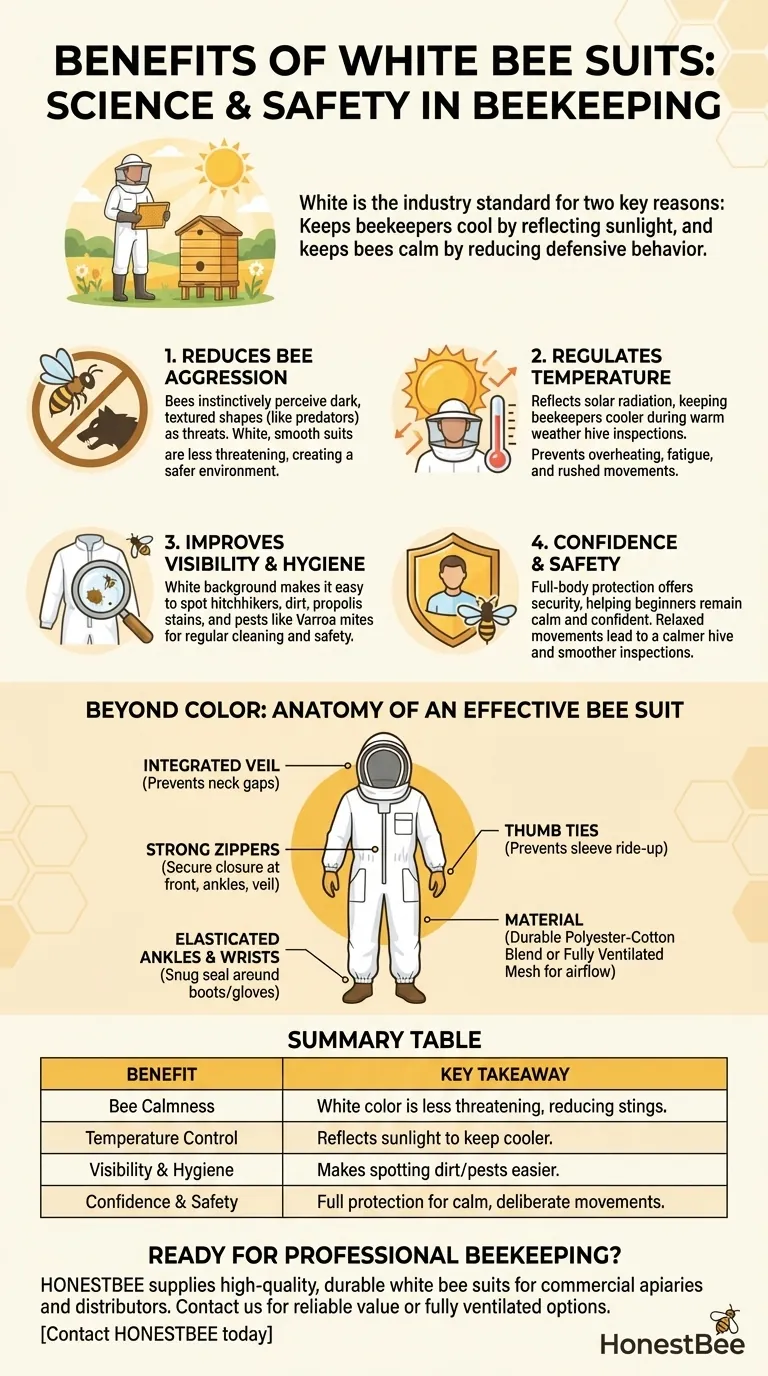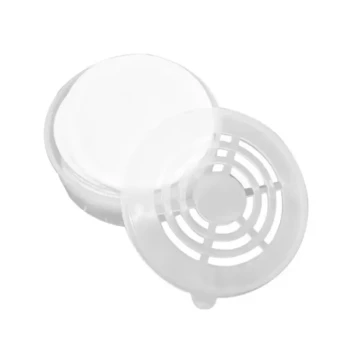At its core, a white bee suit is the industry standard for two fundamental reasons: it keeps the beekeeper cool by reflecting sunlight, and more importantly, it keeps the bees calm. The color white is less threatening to honeybees, reducing their defensive behavior and creating a safer, more productive environment for both the keeper and the colony.
While a full bee suit's primary function is protection from stings, the choice of white is a deliberate strategy rooted in bee biology and the practical challenges of working outdoors. It is a tool for managing both the beekeeper's comfort and the bees' temperament.

The Science Behind the Color: Why White?
The prevalence of white in beekeeping attire is not an accident or a matter of tradition alone. It is a functional choice based on scientific principles of vision, behavior, and thermoregulation.
Reducing Bee Aggression
Honeybees have evolved over millions of years to defend their colony against natural predators. These predators, such as bears, badgers, and skunks, are typically dark and furry.
Consequently, bees are instinctually more likely to perceive dark, textured shapes as threats. A white, smooth suit does not trigger this defensive response, making the bees less likely to become agitated and sting.
Regulating the Beekeeper's Temperature
Hive inspections are most often performed during warm, sunny days when bees are most active. A white suit reflects a significant amount of solar radiation, helping to keep the beekeeper cooler.
This is more than a matter of comfort. Overheating can lead to fatigue, dehydration, and rushed movements, which can stress the bees and increase the likelihood of mistakes.
Improving Visibility and Hygiene
A white background makes it much easier to spot unwanted hitchhikers. You can quickly see a stray bee on your suit before you go indoors.
It also makes it easy to see dirt, propolis stains, or even pests like Varroa mites, encouraging regular cleaning. A clean suit is crucial, as residual alarm pheromones from previous stings can incite future defensive behavior from the colony.
Beyond Color: Anatomy of an Effective Bee Suit
While color is a critical starting point, the overall design and material of a suit are what determine its effectiveness and comfort.
Material and Ventilation
Most standard suits are made from a durable polyester-cotton blend, which offers a good balance of protection and longevity.
For hotter climates, fully ventilated suits are a superior option. These are made of thick mesh layers that are too deep for a bee's stinger to penetrate but allow for significant airflow, keeping the beekeeper much cooler.
Essential Design Features
A well-designed suit provides comprehensive, "bee-tight" protection. Key features include:
- Integrated Veil: A veil that zips directly to the suit prevents any gaps around the neck.
- Strong Zippers: Durable zippers at the front, ankles, and veil are essential for secure closure.
- Elasticated Ankles and Wrists: These create a snug seal around boots and gloves.
- Thumb Ties: Loops that go over your thumb keep the sleeve from riding up when you put on your gloves, preventing exposure at the wrist.
The Confidence Factor
For beginners, the psychological benefit of a full suit is immense. Bees are known to sense fear or tension, which can make them more defensive.
The security of a full suit helps a new beekeeper remain calm and confident, leading to smoother, more deliberate movements. This relaxed state translates to a calmer hive.
Understanding the Trade-offs
Choosing a bee suit involves balancing protection, comfort, and cost. There is no single "best" suit for every person in every climate.
Ventilated vs. Standard Suits
Ventilated suits offer unparalleled cooling, which is a significant advantage in hot weather. However, they are typically more expensive and can be bulkier than standard poly-cotton suits. Standard suits are highly durable and cost-effective but can become uncomfortably hot on summer days.
The Importance of Proper Fit
A suit must be loose-fitting. A tight suit pulls the fabric against your skin, reducing the gap a bee's stinger must cross. This makes you more vulnerable to stings. Conversely, a suit that is excessively large can be cumbersome and snag on equipment.
Maintenance and Lifespan
A bee suit is an investment that requires care. You must launder it regularly to remove propolis, dirt, and alarm pheromones. Failing to do so can make your suit attract more bee aggression over time. Zippers should be kept clean to ensure they function properly.
Making the Right Choice for Your Goal
Your choice of suit should be guided by your climate, budget, and personal comfort level.
- If your primary focus is maximum cooling in a hot climate: A fully ventilated white suit is the superior choice and well worth the investment.
- If your primary focus is all-around durability and value: A standard white polyester-cotton blend suit provides excellent, reliable protection for most situations.
- If you are a beginner feeling nervous about stings: Prioritize a full suit with an integrated veil for the confidence and complete protection it offers.
Ultimately, the right bee suit is a critical piece of equipment that fosters a safe, calm, and effective partnership between you and your bees.
Summary Table:
| Benefit | Key Takeaway |
|---|---|
| Bee Calmness | White color is less threatening to bees, reducing defensive stings. |
| Temperature Control | Reflects sunlight to keep the beekeeper cooler during hive inspections. |
| Visibility & Hygiene | Makes it easy to spot stray bees, dirt, and pests for better safety. |
| Confidence & Safety | Full-body protection allows for calm, deliberate movements around the hive. |
Ready to experience the benefits of a professional bee suit?
HONESTBEE supplies commercial apiaries and beekeeping equipment distributors with high-quality, durable white bee suits designed for maximum protection and comfort. Whether you need a standard poly-cotton blend for reliable value or a fully ventilated suit for hot climates, our wholesale-focused operations ensure you get the right equipment for your needs.
Contact HONESTBEE today to discuss your beekeeping supply requirements and keep your operation safe and productive!
Visual Guide

Related Products
- Wholesales Dadant Size Wooden Bee Hives for Beekeeping
- Yellow Plastic Bucket Pail Perch for Beekeeping
- Long Langstroth Style Horizontal Top Bar Hive for Wholesale
- Professional Insulated Plastic Bee Hives
- Automatic Honey Flow Beehive 4 Frame Mini Hive for Beekeeping
People Also Ask
- What are the essential pieces of equipment for most beekeepers? Get Started with the Right Gear
- What should you do if you find an ant nest near your beehive? Essential Strategies for Hive Protection
- What are the advantages of wooden bee hives? Superior Bee Health & Beekeeper Flexibility
- How often should the area under beehives be inspected and cleaned during the warm season? A Proactive Maintenance Guide
- What should beginners consider when purchasing beekeeping equipment? A Guide to Essential Starter Gear



















